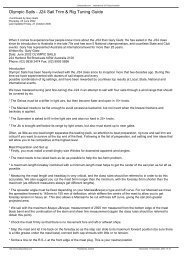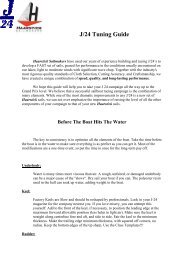UK 1D35_tuning.pdf - Sailmaker.org
UK 1D35_tuning.pdf - Sailmaker.org
UK 1D35_tuning.pdf - Sailmaker.org
You also want an ePaper? Increase the reach of your titles
YUMPU automatically turns print PDFs into web optimized ePapers that Google loves.
SAILMAKERS1-D 35 Tuning GuideBefore stepping the mast:1) Measure and set D2’s to 1 ”. This is measured from the bottomof the turnbuckle to the bottom of the cap (where the captouches the spreader). This should correspond to the hand tightwhen the rig is up.2) Mark upper and lower spreader with tape in the followingmanner to assist trimming the jib.Lower spreader: 1’6”, 1’9”, 2’ in from outer tipUpper spreader: 1’, 1’4”, 1’6” in from outer tipSee pictureShroud tension starting pointUpper shrouds:With zero hydraulic pressure on the headstay, set shroud to handtight plus five turns. Now check the mast to see if it is in the centerof the boat. Attach a steel tape to the centerline halyard. Raise thehalyard to max hoist and cleat the halyard. Measure to the centerof the upper shroud clevis pin at the chain plate. Both sides shouldmeasure the same. After confirming that the mast is centered,tighten the upper shrouds to 4”. The 4” measurement is the portionof the treads that are outside the turnbuckle (see picture).Lower shrouds: Set to hand tight plus one turn. Measure the exposedthreads. This distance should be 3 ”.Check your rake:1) Set hydraulic pressure to 1,000 psi.2) Attach steel tape to center halyard and raise to max hoist andcleat. The distance to the deck at the headstay should be 43’6”.3) Alternative method would be raising a steel tape up to max hoiston the main halyard. Then measure to the centerline on thedeck at the stern of the boat. This measurement should be53’ 10 ”.
SAIL AND RIG SETTING MATRIXTrue Headstay Uppers Lowers Head BarberWind PSI V1 D1 D2 Sail Hauler Traveler Vang4 300 10.1 cm 8.5 cm 4.5 cm Lt 0 +1.75 05 300 10.1 cm 8.5 cm 4.5 cm Lt 0 +1.5 06 600 10.1 cm 8.5 cm 4.5 cm Lt 2” +1.0 07 700 10.1 cm 9.0 cm 4.8 cm Lt in 3" +1.0 08 1200 10.1 cm 9.0 cm 4.8 cm Lt in 3" +1.0 09 1400 10.1 cm 9.0 cm 5.0 cm Lt in 5" +.5 010 1500 10.1 cm 9.5 cm 5.0 cm Medium in 5" 0 011 1900 10.1 cm 9.5 cm 5.0 cm Medium in 4" 0 Light12 2200 10.1 cm 9.5 cm 5.0 cm Medium in 3" -0.5 Light13 2300 9.4 cm 9.5 cm 5.5 cm Medium in 2" -0.5 Medium14 2600 9.4 cm 9.5 cm 5.5 cm Medium in 2" -1.0 Medium15 2900 9.4 cm 9.5 cm 5.5 cm Medium in 1" -1.5 Hard16 3100 9.4 cm 10.6 cm 6.0 cm Medium None -1.5 Hard17 3200 8.6 cm 10.6 cm 6.0 cm Medium None -2.0 X-Hard18 3300 8.6 cm 10.6 cm 6.0 cm Medium None -2.0 X-Hard19 3400 8.6 cm 10.6 cm 6.4 cm Small None Bottom X-Hard20 3600 8.6 cm 10.6 cm 6.4 cm Small None Bottom X-Hard21+ 3800 8.6 cm 10.6 cm 6.4 cm Small None Bottom XX-hardYou will need to check that your shrouds are all the same length. Wefound that the V1 on TSUNAMI were the same. However, the D2 were4mm different and the D1 were 3mm different from port to starboard.There are minor differences in stay lengths between all the boats, so theabove setting may be slightly different for your boat. The relative differenceswill work for any boat. However, you will need to establish yourown starting point.
Mainsail Shape: 7 knots true windMainsail Shape: 14 knots true windJib Halyard NoteJib halyard tension must beadjusted in unison with headstaytension. To prevent damage tothe jib luff, always ease the jibhalyard prior to letting off theheadstay. Many boats haveattached the jib tack shackle tothe clevis pin at the bottom ofthe spectra headstay strap. Thisminimizes the need to adjust thejib halyard. The shackle heightshould be adjusted so that theyare right on the deck with 4.000psi on the headstay. With minimalhydraulic tension, the shackleswill rise approximately 3” offthe deck (see picture below).Light Genoa Shape: 7 knots true windJib Tack AdjusterHeavy Genoa Shape: 17 knots true wind
















